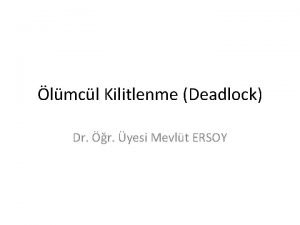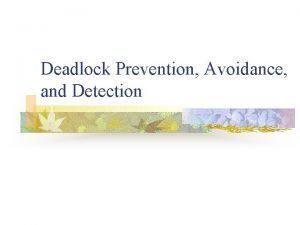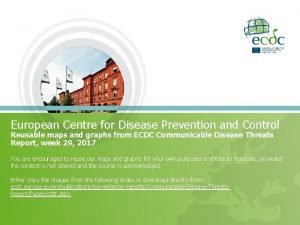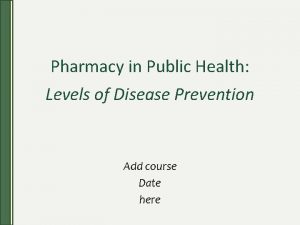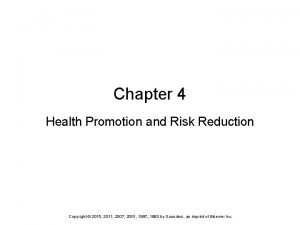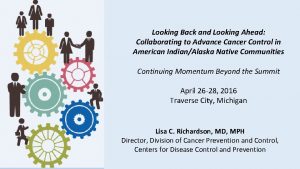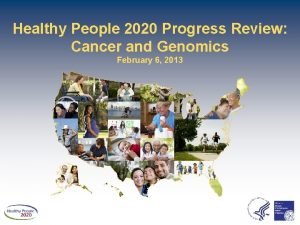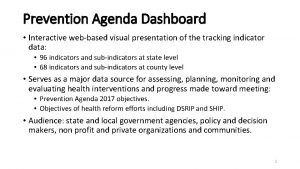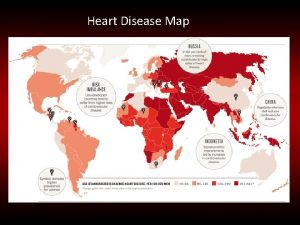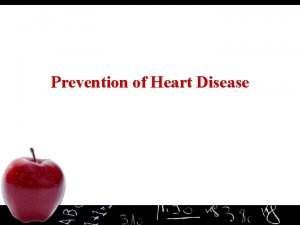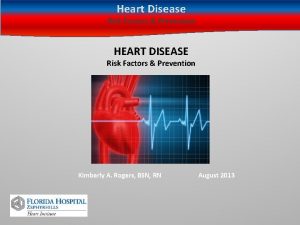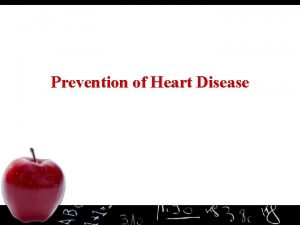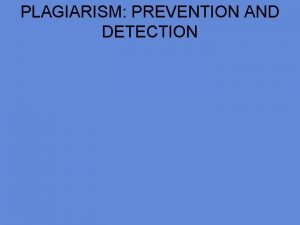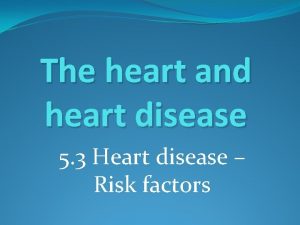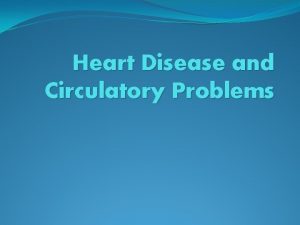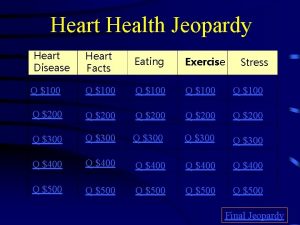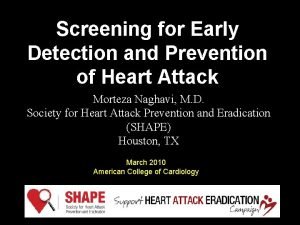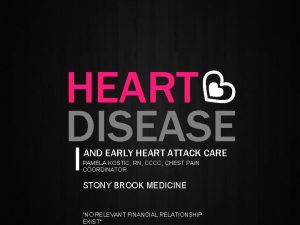Early Heart Disease Detection and Prevention Programs Agenda














- Slides: 14

Early Heart Disease Detection and Prevention Programs

Agenda • Who We Are • Why Heart Disease? • Services Overview • Why Heart. Savers?

Who We Are • Experts in Early Cardio. Vascular Disease detection and prevention • Founded in 2000 at the University of Minnesota as the Rasmussen Center for Cardio. Vascular Disease Prevention • Affiliated agreement with Rasmussen and University of Minnesota • Locations in Minnesota, Georgia, Florida, Louisiana, and Manitoba, Canada

Why Heart Disease? • Heart Disease is the leading cause of death in the United States, more than AIDS and ALL cancers combined • Heart Disease is also the most expensive and costly of the chronic diseases, almost by a 2 to 1 margin • In 2008, the total cost (direct and indirect) of cardiovascular disease in the U. S. was estimated at $448. 5 billion • This year more than 920, 000 Americans will have a heart attack; nearly half of them will occur without prior symptoms or warning signs

Heart Disease Facts • 50% of heart attack victims have normal blood pressure levels • 50% of heart attack victims have normal cholesterol levels • 75% of stroke victims have normal blood pressure levels. 4 out of 5 stroke victims have no apparent warning signs • Cardiovascular disease is the number one killer of women over age 25 in the United States

Heart Disease Facts • Nearly twice as many women in the United States die of heart disease and stroke than from all forms of cancer, including breast cancer • Nearly two-thirds of American women who die suddenly of a heart attack had no symptoms • One in every three women dies of heart disease. However, only 20% of women consider heart disease to be their own greatest health risk • It is estimated that 80% of cardiovascular disease can be reversed or eliminated

Services Overview - Intro • Now there is a screening test that is the earliest detection of heart disease known today • Our screening test identifies heart disease even before plaque develops in the blood vessels • Our screening test can detect heart disease in people without symptoms

Services Overview – Cardio 101 • Cardio 101 – Our initial heart disease screening service – Consists of 4 tests and takes only 15 minutes – Simple, safe, accurate, inexpensive – Non-invasive, quick, painless, no radiation – Identifies the 40% (on average) of a population that has some stage of heart disease

Services Overview – Cardio 1000 • Cardio 1000 – Our second stage heart screening service – Identifies the severity, location, and specificity of heart disease – Consists of 10 non-invasive tests plus blood test and urine sample analysis – Service takes approximately 1 ½ hours – No radiation or expensive tests involved – Reimburseable and covered by most insurance plans

Services Overview - Results • Cardio. Number – our patented test result system that numerically identifies the employees heart disease stage • All screenings involve immediate results via print, email, or online customer portal • Cardio 1000 results include an individualized treatment plan to stop/reverse heart disease

Why Heart. Savers? • Preventing just one heart attack saves a life • Detection and prevention program focused on largest chronic disease is needed • Earliest detection of heart disease known today • Initial screening for all employees is fast, affordable, and non-invasive

Why Heart. Savers? • Typical return on investment follows other wellness ROI statistics – “Medical costs fall by about $3. 27 for every dollar spent on wellness programs and absenteeism costs fall by $2. 73 for every dollar spent. ” • Baicker, K. , Cutler, D. , and Song, Z. (2010). Workplace Wellness Programs Can Generate Savings. Health Affairs. 29(2): pg. 304 • Additional cost savings are generated for health care system as a whole when heart disease is treated before a heart attack or stroke

Why Heart. Savers? • Proven to promote change behavior and motivate people to improve their health habits • Proven to motivate people to comply with their medications and disease management programs • Earlier detection is tremendously inexpensive when compared to letting people have heart attacks

Why Heart. Savers? • Why we are different: – Focus on heart disease only, the largest and most expensive chronic disease – Focus on detection and prevention, which is much less expensive than chronic disease management – Specialize in detecting heart disease in people without symptoms – Focus on early detection, before plaque can build up in blood vessels – Easily integrates with your current wellness programs and/or disease management programs
 Primary prevention secondary prevention tertiary prevention
Primary prevention secondary prevention tertiary prevention Starvation deadlock
Starvation deadlock Deadlock prevention or avoidance
Deadlock prevention or avoidance Chapter 19 disease transmission and infection prevention
Chapter 19 disease transmission and infection prevention Chapter 26 infectious disease prevention and control
Chapter 26 infectious disease prevention and control Chapter 19 disease transmission and infection prevention
Chapter 19 disease transmission and infection prevention European centre for disease prevention and control
European centre for disease prevention and control Health promotion and levels of disease prevention
Health promotion and levels of disease prevention Chapter 19 disease transmission and infection prevention
Chapter 19 disease transmission and infection prevention Health promotion and levels of disease prevention
Health promotion and levels of disease prevention Prevnet
Prevnet National breast and cervical cancer early detection program
National breast and cervical cancer early detection program National breast and cervical cancer early detection program
National breast and cervical cancer early detection program Cpmcd full form
Cpmcd full form Prevention agenda dashboard
Prevention agenda dashboard

